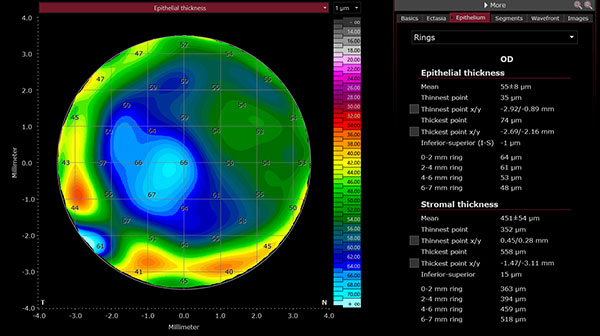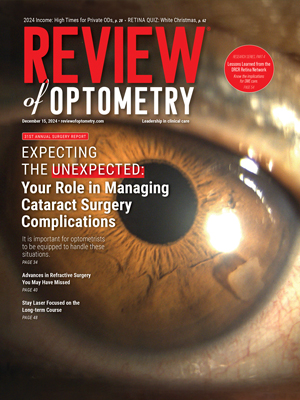 |
|
|
In a recent study, researchers from Portugal investigated corneal epithelial thickness in patients with dry eye disease (DED) according to symptomatology. They found that patients with more severe symptoms have thicker corneal epithelia and thinner stroma. The team’s paper on the work was recently published in Clinical Ophthalmology. The authors believe this is the first study to report stromal thinning in patients with DED.
Enrolled were 200 eyes (of 100 individuals) divided into two groups based according to the severity of symptoms in the dry-eye related questionnaire (OSDI-12): 65 in group 1 (mild disease) and 135 in group 2 (moderate-to-severe disease). Each patient underwent corneal epithelial thickness mapping with swept-source OCT and automated ocular surface analysis. Schirmer’s test and tear film osmolarity were also evaluated.
Patients with more severe disease had thicker epithelia, which is in accordance with some studies, but in contradiction with others. “The inflammatory component of DED causes disruption of the epithelial barrier via promotion of cellular apoptosis and production of pro-inflammatory substances, such as matrix metalloproteinases,” the authors wrote. “These proteolytic enzymes break intercellular junctions and disrupt the epithelial barrier. Epithelial proliferation and cellular size variation seem to be a compensatory mechanism against dry-eye induced apoptosis and epithelial cell damage, which may explain our results.”
There is also reciprocal thinning in stromal thickness, which may be secondary to epithelial imbalance with the release of proteolytic enzymes and collagen degradation, similar to what seems to occur in eyes with keratoconus. On the other hand, increased tear film evaporation in patients with more severe symptoms may also explain stromal thickness reduction, the authors wrote.
“As we know, the epithelium seems to compensate structural changes in the corneal stroma; we consider this an additional marker of cellular damage and a response to epithelial cell hyperplasia and local disruption,” the authors explained.
They also found that patients with more severe disease seem to present thinner superior corneal epithelium, which correlates with previous studies. “On one hand, this may be explained by an increased blinking to compensate for tear film deficiency, which promotes upper eyelid rubbing on the cornea, hereby thinning the superior region of the epithelium,” the authors wrote. “On the other hand, Rattan et al. concluded that dry eye patients had thicker inferior epithelium, which seems to be confirmed in our results by a positive difference between inferior and superior epithelial regions; this may translate cellular hyperplasia in response to a deficient tear film.”
Another study proposed that epithelial thickness in patients with DED was more altered in the peripheral cornea; however, the epithelial and stromal thickness variation seemed to be sustained both in the peripheral, paracentral and central zones of the cornea. Evidence is still lacking, the authors noted, and more studies are needed to confirm both hypotheses.
Also evaluated was the topographic thickness variability index, measured as the mean standard deviation of the mean epithelial thickness over a 7mm area centered in the corneal vertex, and it was found that patients with more severe dry eye have higher variability, which was expectable and in line with other studies, according to the authors. “We believe this is an additional indicator of an imbalance between cellular proliferation and apoptosis, probably reflecting abnormal cellular shape and size,” they wrote.
| Click here for journal source. |
Ribiero BB, Heitor Marques J, Baptisa PM, et al. Corneal epithelial thickness correlation with dry eye symptom severity: a cross-sectional study. Clin Ophthalmol. November 20, 2024. [Epub ahead of print.] |


